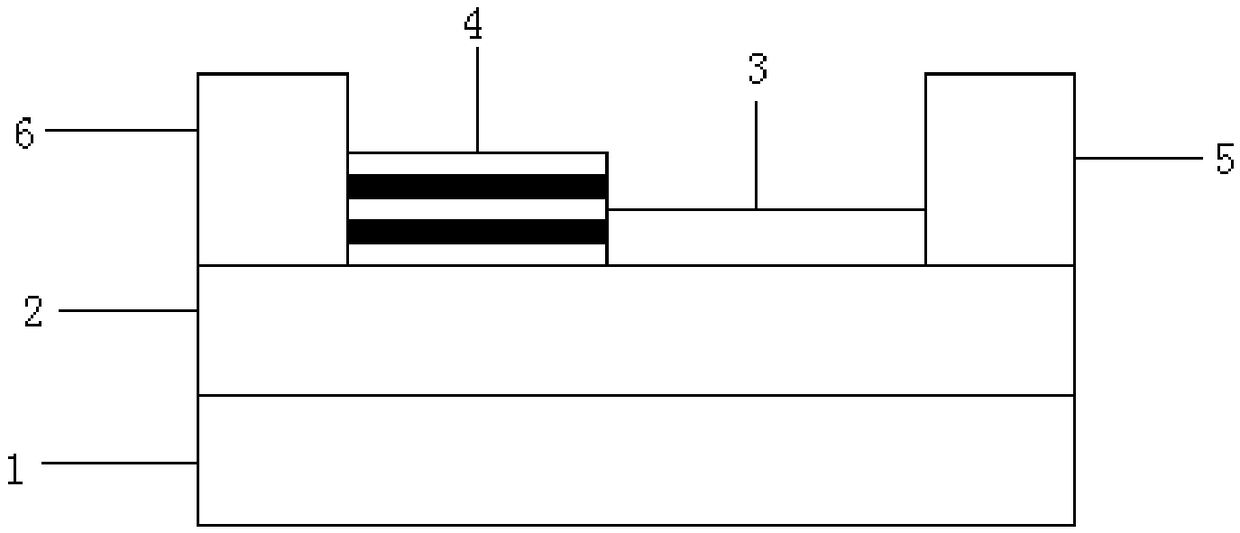Efficient two-dimensional superlattice heterojunction photovoltaic device and preparation thereof
A photovoltaic device and superlattice technology, applied in the field of efficient two-dimensional superlattice heterojunction photovoltaic devices and their preparation, can solve problems such as being unsuitable for multi-layer periodic superlattice, and achieve excellent mobility and stability properties, weakening interlayer coupling, and high light absorption efficiency
- Summary
- Abstract
- Description
- Claims
- Application Information
AI Technical Summary
Problems solved by technology
Method used
Image
Examples
Embodiment 1
[0029] A high-efficiency two-dimensional superlattice heterojunction photovoltaic device with a structure such as figure 1 As shown, it at least includes a substrate 1, a silicon dioxide layer 2 grown on the substrate 1, and a multi-layer two-dimensional material covered on the silicon dioxide layer, and each layer in the multi-layer two-dimensional material part area Organic molecular layers are embedded between them to form a two-dimensional superlattice structure 4. The two-dimensional superlattice structure 4 is composed of a two-dimensional material layer 41 and an embedded organic molecular layer 42. Its structure is as follows figure 2 As shown, the two-dimensional superlattice structure 4 and the multi-layer two-dimensional material 3 not embedded in the organic molecular layer 42 form a two-dimensional superlattice heterostructure, and two ends of the two-dimensional superlattice heterostructure are respectively grown with metal electrode.
[0030] The preparation m...
Embodiment 2
[0038] A highly efficient two-dimensional superlattice heterojunction photovoltaic device, the structure of which is the same as in Example 1, except that the preparation method is changed to:
[0039] First, polysilicon is used as the substrate material, and a silicon dioxide film is grown on the substrate layer with a thickness of 100 nm.
[0040] Then, a layer of black phosphorus is adopted by mechanical peeling method, and the black phosphorus is multi-layered with a thickness of more than 2.5nm. It is then transferred onto the silicon dioxide layer by transfer technology.
[0041] Afterwards, a layer of photoresist is covered on the part of the black phosphorus.
[0042] Then, the device structure composed of polysilicon, silicon dioxide and black phosphorus was immersed in an electrolyte solution of tetrabutylammonium bromide.
[0043] Subsequently, a working electrode, a counter electrode and a reference electrode were fabricated. The working electrode material is pl...
Embodiment 3-7
[0047] The difference from Example 1 is that in this example, the multilayer two-dimensional materials are replaced by molybdenum disulfide, tungsten diselenide, indium selenide, tin selenide or germanium sulfide.
PUM
| Property | Measurement | Unit |
|---|---|---|
| thickness | aaaaa | aaaaa |
| thickness | aaaaa | aaaaa |
| thickness | aaaaa | aaaaa |
Abstract
Description
Claims
Application Information
 Login to View More
Login to View More - R&D
- Intellectual Property
- Life Sciences
- Materials
- Tech Scout
- Unparalleled Data Quality
- Higher Quality Content
- 60% Fewer Hallucinations
Browse by: Latest US Patents, China's latest patents, Technical Efficacy Thesaurus, Application Domain, Technology Topic, Popular Technical Reports.
© 2025 PatSnap. All rights reserved.Legal|Privacy policy|Modern Slavery Act Transparency Statement|Sitemap|About US| Contact US: help@patsnap.com


